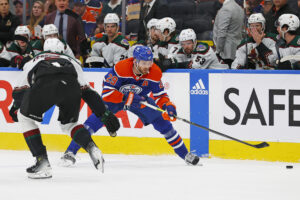Matthew Beniers, remember his name. Beniers is a Michigan Wolverine’s product, playing with Kent Johnson, a fellow 2021 draft eligible. He caught my eye watching Michigan when he was the guy driving the play as opposed to his linemate, Johnson, who has been ranked higher by most outlets. At least, at the time I watched that game I tracked. But what else makes Beniers a special talent?
Matthew Beniers is a Name to Remember
Beniers, born on November 5th, 2002, in Hingham, Massachusetts, is a 2021 eligible prospect, who I have ranked 5th. Generally, the 6’1”, 174 pound center is ranked, on average, at 12th. What he brings to the table, however, draws some comparison to another prospect, drafted last year, who I had ranked ahead of most outlets. That player is Anton Lundell.
Lundell stands at 6’1” and 190 pounds, making him slightly more built. However, their size is similar. Both players play down the middle as centers, as well. Also similar between the two, their birthdays make them older than the majority of other prospects in their class. That trait is what held Lundell back in some rankings, as his maturity and experience was ahead of some other prospects in his class. In Beniers’ case, he got a chance to enter the NCAA ranks with Michigan earlier, while a guy like Matthew Knies has to remain in the USHL.
Two-Way Dominance
Beniers came into his draft year being a well-known 200-foot player. He was praised for his work ethic and awareness in all three zones, as well as his ability to defend extremely well. Lundell entered – and ended – his draft year as one of the best two-way forwards to enter the draft in a very long time. In fact, Lundell’s game compared favorably to some of the best two-way forwards in the NHL today, like Patrice Bergeron. Both play a detail-oriented and anticipation-laden defensive style.
Beniers is always involved in the play on defense. He is aggressive on the puck carrier, taking the right angles more often than not. Beniers is also strong in puck battles and displays strong acceleration, allowing him to stay in position and win races to loose pucks.
Meanwhile, Lundell also is involved constantly in the defensive zone. He keeps his eyes and head moving, keeping track of everyone on the ice, and takes calculated risks when attacking the puck carrier. He is less aggressive than Beniers, and relies heavily on his anticipation and IQ to make stops. Just like Beniers, Lundell has good acceleration, which allows him to win those all-important races to loose pucks.
Anton Lundell Had More Than Meets The Eye
Lundell was grossly underrated, and the fact is this. If a forward is more known for their defensive prowess then their production, then their upside must be limited. That was the idea on Lundell for the draft, despite the fact he showed flashes in his offensive game. I tracked one game on Lundell’s offensive zone play, tracking his passing and shooting attempts. He sent 14 total pass attempts in the offensive zone, connecting on each and every one of them. Seven of them were deemed “simple” passes, one was a centering pass, two were cross-ice passes, and four were cycle passes. Lundell also had four shot attempts, all from the perimeter, with all four hitting the net.
I also tracked four of Lundell’s Liiga games, tracking his transitional numbers. He was involved in 24 zone exit attempts directly. He completed 16 of those with possession, with five being passes out to a teammate and 11 featuring him carrying the puck out himself. That’s an average of four breakouts with possession per game. He dumped the puck out and failed to clear four times each, which is an average of 1 dump and fail per game.
Lundell was also involved in 36 zone entries, which is an average of 9 zone entries per game. Of those 36 entries that Lundell impacted, 15 were done with possession, with five passes and 10 carries. That is an average of 3.75 zone entries with possession per game. Lundell dumped the puck in 14 times (3.5 per game), and failed to gain entry on seven attempts (1.75 per game).
Matthew Beniers Also Has More to Add
Just like Lundell, Beniers also has a strong skill set in the transitional game. The reason I averaged out Lundell’s stats is because I only have one game tracked on Beniers. Keep in mind when reading these stats that Lundell played in a men’s professional league in Finland, while Beniers is playing college kids in the NCAA.
Beniers, in the game I tracked against Penn State, had 10 offensive zone pass attempts. He completed eight of them. Of the 10 attempts, three were “simple” passes, three were centering passes, two were cross-ice passes, and two were cycle passes. Beniers registered one shot attempt, coming from the perimeter, but missing the net.
Transitionally, Beniers was the driver of his line in Michigan. He has favorable numbers in these categories. For exits, he was involved in 11 breakouts. Six of them were cleared with possession, with two being passed and four being carried. He dumped the puck out twice and failed twice. Beniers also iced the puck once, though it wasn’t really his fault.
When entering the offensive zone, Beniers was involved in seven entries. Six of them were made with possession, with five passes and one carry. He dumped it in once and did not fail to gain entry on any of his attempts.
What do the Numbers Show?
When taking into account the level of difficulty, Lundell looks like the better transitional player. When it comes to breaking out of the defensive zone, Lundell pushes the pace a bit more. He doesn’t settle for dump-ins and tries to be as efficient as possible, and not allow his opponents to hold the puck in the offensive zone. Overall, however, the numbers are very close. Due to the leagues they’re playing in, however, Lundell gets the nod. But again, Beniers is right there with him.
When entering the offensive zone, Lundell likes to get more involved than Beniers. While Beniers gets down and dirty when breaking the puck out, he tends to take a back seat when entering the offensive zone. This is not a negative trait, but rather a testament to his straight-forward, simply playstyle. Lundell, on the other hand, likes being right in the middle of it all, even if it means not always getting in cleanly. While Lundell likes being efficient on the breakout, he plays with confidence, risk and creativity when entering the zone, and that’s what makes him intriguing on transition. Again, playing against men in Finland makes his numbers all the more impressive to see.
Offensively, Lundell is more of a shooter than Beniers. However, he only had 99 shots in 44 games in his draft year, averaging 2.25 shots per game. Combining his USHL and USDP stats from last year, Beniers recorded 88 shots in 44 games, which is an average of two shots per game. Virtually, they are both pretty even when it comes to utilising their shots, but Lundell is a better shooter. When it comes to passing the puck, Lundell plays a smart and safe style. He passes the puck to the open man and tries to filter the puck and maintain possession. Beniers is a bit more creative with the puck, opting to try more lanes and get the puck into higher danger situations. So, while Lundell projects a bit better as a goal-scorer, Beniers looks like a guy with strong playmaking abilities.
Beyond the Numbers
Beyond just what I have tracked, these two players are fairly similar overall. Both are strong skaters, with Beniers the better of the two. However, they both have a flaw in their strides which limit just how effective they are. Lundell leans too far forward and his strides are a bit choppy, while Beniers needs to lengthen his strides a bit more. But again, the way their skating is now is absolutely not a concern.
Both guys facilitate the puck and run a very strong and underrated offensive style. Beniers, though more of a creative playmaker, is looked at as a bashful forward. He gets praised for his relentless forechecking and getting to the dirty areas. However, he does not get enough credit for his creativity.
Lundell also gets to the dirty areas, having a tendency to get to the net-front consistently. But he did not get a whole lot of attention for his incredible shot, which features a sneaky good release, high-end accuracy, and a lot of power. He was able to prove quickly in his DY+1 season that he has offensive upside. In fact, he has recorded 12 goals and 20 total points in just 17 Liiga games.
Based on their similar defensive abilities, hidden offensive upside, solid transitional statistics, and a phenomenal work ethic, Beniers could be the Anton Lundell of the 2021 NHL Entry Draft. In other words, I am going to praise this kid relentlessly over the course of the year and rank him considerably higher than everyone else until draft day. As for Lundell, the Florida Panthers found an absolute gem, and they are reaping their rewards in the form of a breakout Liiga season in 2020-21.
Main Photo:






